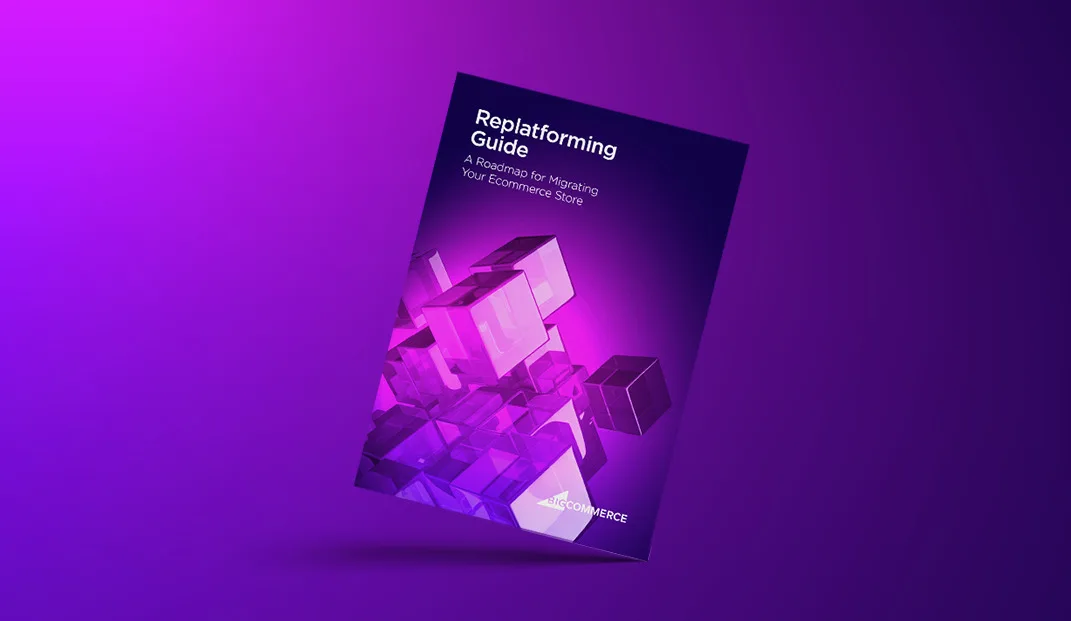
Replatforming Guide: A Roadmap for Migrating Your Ecommerce Store
Make your ecommerce replatforming project a success with our step-by-step guide filled with best practices from enterprise migration experts.

Preparing for 2023: BigCommerce Leaders Share Their Insights


Preparing for 2023: BigCommerce Leaders Share Their Insights
Get The Print Version
Tired of scrolling? Download a PDF version for easier offline reading and sharing with coworkers.
A link to download the PDF will arrive in your inbox shortly.
The beginning of the year is a chance to get a jump on the challenges and opportunities ahead or even just reset and begin planning. This couldn’t be more true for online retailers.
In 2022, we saw the emergence of a number of trends with staying power in areas like alternative payment methods, omnichannel selling and headless commerce.
BigCommerce tapped its foremost subject matter experts for a roundup of predictions and insights around these trends and more to create a comprehensive picture of what we can expect in the coming year.
Staying Ahead of the Curve in 2023
Now is the time to ensure your business has a great 2023. To do so, brands need to be up to speed on the latest ecommerce trends. Here are some insightful thoughts from BigCommerce leadership on where the industry is headed this year.
Data feed optimization will be imperative to omnichannel marketing success.
Sharon Gee, Vice President of Revenue Growth and General Manager of Omnichannel

“For retailers and merchants, an omnichannel strategy is no longer an option, but an imperative. Consumers are shopping smarter and want the convenience of shopping where they want, when they want and how they want. Optimizing data feed across all social and marketplace channels is crucial for businesses, especially those in the digital commerce space. It requires an optimized and structured data feed mapped and aligned with how users search for specific products on various marketing channels.
“We should also expect to see retailers advancing their omnichannel strategies to the next level with modern technologies such as AI and live broadcast shopping to ensure consumers are engaged and shopping experiences feel personal–both online and in-store. Retailers who meet these expectations will be well positioned to succeed for the long term.”
Alternative payment methods will move further to the forefront and be a major opportunity for retailers to boost sales revenue.
Mark Rosales, Vice President of Business Development, Payments, Banking, Fintech

“Buy Now, Pay Later (BNPL) solutions have been growing in popularity for years, but the trend exploded in 2021 and surged even more during Cyber Week 2022 as more budget-conscious consumers carefully managed their spend and gift buying. Digital Wallets such as PayPal, Apple Pay, Amazon Pay, Google Pay and Venmo will continue to reign as we expect to see more providers enter the space.
“With hybrid shopping in full swing, we will also see more forward-thinking retailers embrace alternative payment methods including fashion and home & garden stores. Credit cards won’t become obsolete, but those that have them will use cards on an as needed or required basis, forcing retailers to upgrade payment methods to stay competitive. Those that don’t have cards require alternative payment methods.”
Rosales: Efficiency at point of purchase will continue to improve how buyers pay.
“Expanding the ways in which shoppers can pay for items is the result of new developments in the areas of a website where buyers can pay. For instance, when shopping for an athletic T-shirt, at the point of discovery a potential buyer can be given the option to purchase the item without having to add it to the checkout and complete the purchase later. This greatly enhances conversion.
“Additionally, relocating pay now and digital wallet buttons at the top of the checkout removes friction from the buying experience. Using pre-configured tokenized credentials from a digital wallet network to enable one-click checkout speeds up the purchase process. These improvements to the merchant’s checkout design and experience will significantly improve merchant sales and customer satisfaction.”
Headless technology will become the future of modern B2B commerce.
Meghan Stabler, Senior Vice President of Global Product Marketing

“Headless technology has been around for a number of years, providing a flexible solution for retailers who need to ditch legacy monolithic platforms for a modern B2B commerce experience to deliver rich and engaging website content that consumers have come to expect — without interfering with the back-end of their ecommerce site.
“Traditionally the technology has catered to DTC merchants, but that is changing. Expect to see B2B merchants turning to headless as a critical business strategy to modernize their ecommerce operations to provide their customers with B2B functionalities for business-specific purchasing, while offering the visual, content-focused experience that gives the feel of a B2C site.”
Stabler: Composable commerce will emerge as the future of modern commerce.
“Following three-straight years of uncertainty and rapid change, 2023 looks like it’s going to offer more of the same but with even more challenges for a wide range of businesses. Ecommerce merchants won’t be immune. In times of uncertainty and change, merchants must make smart technology investments that are agile, functional and flexible. They need to invest in modern technology that enables, not hinders, delivering cutting-edge shopping experiences. Without a flexible commerce solution, it’s next to impossible to drive growth, especially during economic downturns.
“In 2023, we’ll see composable commerce, a modular approach that allows merchants to customize their tech stacks by choosing interchangeable solutions to suit their unique business requirement, emerge as the preferred model for forward-thinking B2C and B2B merchants.
“Composable commerce gives merchants the freedom to mix, match and combine best-in-breed tech vendors to create a customized and robust stack that responds to unexpected change. While a monolithic, one-size-fits-all approach used to be sufficient, it is now antiquated and won’t sustain retail business innovation and growth for the long term. Now is the time to make the digital investments that will provide flexibility during near-term challenges and a strong competitive advantage when the economy rebounds.”
Rosie Rivel, Chief Information Officer

“Gartner predicts that in five years, more than 50% of enterprises will use industry cloud platforms to accelerate their strategic initiatives. It’s important for organizations to prioritize investment in industry cloud platforms, even despite the current macroeconomic conditions. A refocus on adding value in customer journeys and driving improved insights as cloud platforms are implemented, will ensure a strong, scalable foundation for growth as the market recovers.
“Industry cloud platforms use a combination of SaaS, PaaS and IaaS with industry-specific functionality to deliver scalable solutions and with modular architecture, can be recomposed to create either GTM (go to market) value differentiation or use standard preconfiguration to drive operational efficiencies. Organizations that do not invest in their digital transformation may find themselves even more behind as industry cloud platform adoption creates a multiplier effect.”
Matt Crawford, General Manager, Shipping & Tax; Senior Director of Strategic Business Development

“We’ll continue to see the shift from ‘fulfill myself” to leveraging third-party logistics in order for merchants to leverage an omnichannel strategy, accelerate delivery times and reduce costs. Merchants that fulfill themselves will continue to be at a disadvantage as carrier costs continue to increase.
“The exorbitant long lead-times merchants have become accustomed to over the last 24 months will go away, exchanged with higher prices due to inflation and lower demand. Brands will need to get back to efficient buying to avoid major inventory issues.
“Global expansion will accelerate. It’s becoming easier and easier for merchants to think of the world without borders and sell, directly and through channels, to consumers outside the store’s home country.”
Dan Holden, Vice President of Cybersecurity

“Attackers don’t break in, they login. Identity continues to be the focus for attackers, and PCI 4.0 will bring new requirements around multi-factor authentication (MFA). Enabling MFA today will not only get you a head start on PCI 4 when it takes effect in March 2024, but will also help protect your store from being accessed by attackers. I expect we’ll see more merchants implement MFA to get ahead of the requirement, as well as better protect their stores and customers.”
Aaron Sheehan, Director of Competitive Intelligence

“I predict that 2023 will bring increasing commodification of headless implementations as agencies and platforms build accelerators and connectors. The winners will be those who build or buy an ecosystem of partners and related solutions, and the losers will be those who are too undercapitalized to evolve.
“Associations like the MACH Alliance will take on greater importance as stewards of this community, and will be looked upon as lighthouse keepers by merchants.”
Jordan Sim, Senior Director of Product Management

“We will see strong consumer demand and discretionary spending in the first half of the year. Credit will kick in mid-year and start drying up in the second half of the year, resulting in depressed discretionary spending towards the end of 2023.
“Purse strings will be tighter across the board. CFOs will have the final say on the majority of purchases. Retailers want to find the right commerce platform that operates within their budgets and gives them flexibility to achieve their sales goals. Discussions around BNPL will heat up around control and regulation. More B2B merchants will come online, as buyer expectation for modern digital buying experiences increases.”
The Final Word
From budget consciousness and cybersecurity awareness to payment option flexibility and headless implementations, retailers have a number of areas where they can focus in 2023 to become or remain competitive.
BigCommerce will keep tracking these trends and continue passing along the observations and advice to give you an edge.

Pablo Gallaga is a Senior Manager of Content Marketing at BigCommerce where he focuses on thought leadership content. His years of experience in tech, from startups to enterprise, inform his ecommerce insights.


